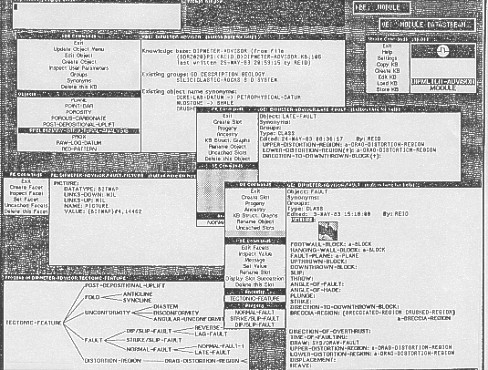|
 Dipmeter
Advisor - An Expert System
Dipmeter
Advisor - An Expert System
Schlumberger's DIPMETER ADVISOR system attempts to emulate human
expert performance in dipmeter interpretation. It utilizes dipmeter
patterns together with local geological knowledge and measurements
from other logs. It is a typical example of the class of programs
that deal with what has come to be known as signal to symbol transformation.
The best description of the program appears in “The Dipmeter
Advisor System”, IJCAI, 1983, by Reid Smith and James Baker.
The
system is made up of four central components:
- a number of production rules partitioned into several distinct
sets according to function (eg., structural rules vs stratigraphic
rules).
- an inference engine that applies rules in a forward-chained
manner, resolving conflicts by rule order.
- a set of feature detection algorithms that examines both dipmeter
and open hole data (eg., to detect tadpole patterns and identify lithological zones).
- a menu-driven graphical user interface that provides smooth
scrolling of log data.
There
are 90 rules and the rule language uses approximately 30 predicates
and functions. A sample is shown below, similar to an actual interpretation
rule, but simplified somewhat for presentation:
IF
there exists a delta dominated, continental shelf marine zone
AND there exists a sand zone intersecting the marine zone
AND there exists a blue pattern within the intersection
THEN assert a distributary fan zone
WITH top = top of blue pattern
WITH bottom = bottom blue pattern
WITH flow = azimuth of blue pattern
The
system divides the task of dipmeter interpretation into 11 successive
phases as shown below. After the system completes its analysis
for a phase, it engages the human interpreter in an interactive
dialogue. He can examine, delete, or modify conclusions reached
by the system. He can also add his own conclusions. In addition,
he can revert to earlier phases of the analysis to refer to the
conclusions, or to rerun the computation.
1.
initial examination: The human interpreter can view the available
data and select logs for display.
2. validity check: The system compares log data with user defined
criteria to find evidence of tool malfunction or incorrect processing.
3. green pattern detection: The system identifies zones in which
the tadpoles have similar magnitude and azimuth.
4. structural dip analysis: The system merges and filters green
patterns to determine zones of constant structural dip.
*5. preliminary structural analysis: The system applies a set
of rules to identify structural features (eg., faults).
6. structural pattern detection: The system examines the dipmeter
data for red and blue patterns in the vicinity of structural features.
*7. final structural analysis: The system applies a set of rules
that combines information from previous phases to refine its conclusions
about structural features (eg., strike of faults).
8. lithology analysis: The system examines the open hole data
(eg., gamma ray) to determine zones of constant lithology (eg.,
sand and shale).
*9. depositional environment analysis: The system applies a set
of rules that draws conclusions about the depositional environment.
For example, if told by the
human interpreter that the depositional environment is marine,
the system attempts to infer the water depth at the time of deposition.
10. stratigraphic pattern detection: The system examines the dipmeter
data for red, blue, and green patterns in zones of known depositional
environment.
*11. stratigraphic analysis: The system applies a set of rules
that uses information from previous phases to draw conclusions
about stratigraphic features (eg., channels, fans, bars).
An
asterisk indicates that the phase uses production rules written
on the basis of interactions with an expert interpreter. The remaining
phases do use rules, but these must be specified entirely by the
user. A sample screen is shown below.

A messy montage of Dipmeter Advisor screens
During
the creation of these components, Schlumberger has developed a
number of proprietary software tools for constructing expert systems.
These include STROBE for definition of data representation, rule
definition and rule integrity checking; IMPULSE for data entry
to STROBE; XPLAIN for justifying and explaining rules and deductions;
CRYSTAL for interactive display of data, graphics, window management
on the screen, as well as task definition; and a relational data
base manager. The tools are written in Interlisp-D on Xerox equipment,
or Commonlisp and C on DEC VAX equipment. Some processing is done
by a host computer which communicates with the Xerox workstation.
The
Dipmeter Advisor is in use within Schlumberger as a test-bed for
further development and for some consulting/interpretation jobs.
|

